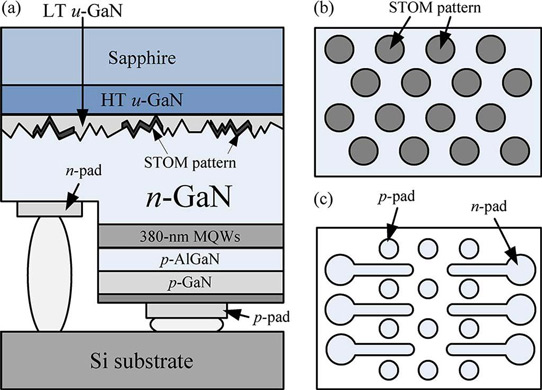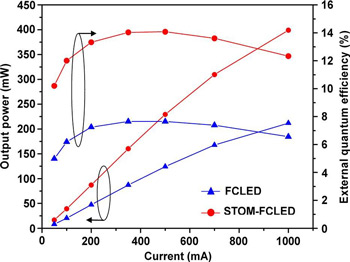- News
17 January 2013
Self-textured oxide mask enhances UV LED external quantum efficiency by up to 83%
Taiwan researchers have used a self-textured oxide mask (STOM) as a template to enhance the external quantum efficiency (EQE) of nitride 380nm ultraviolet (UV) light-emitting diodes (LEDs) by up to 83% [Kun-Ching Shen et al, IEEE Electron Device Letters, published online 02 January 2013]. The researchers are variously associated with National Chung Hsing University, Da-Yeh University, Formosa Epitaxy Inc, and National Cheng Kung University.
The nitride semiconductor layers began with a layer of undoped gallium nitride (HT u-GaN) on sapphire substrate grown at high temperature. Next, a textured surface was created with a low-temperature (LT, less than 800°C) growth step.
Construction of the STOM began with inductively coupled plasma chemical vapor deposition (ICP CVD) of silicon dioxide (SiO2). The SiO2 was patterned in a hexagonal arrangement using photolithography and carbon tetrafluoride plasma etch.
New nitride semiconductor growth was started with a thin layer of aluminium nitride (AlN, less than 100nm), followed by 3μm of n-GaN, a 380nm-wavelength multi-quantum well (MQW) active region, 20nm of p-AlGaN cladding, and a p-GaN contact. The MQW consisted of ten periods of In0.02Ga0.98N/Al0.08Ga0.92N.
The material was used in a flip-chip LED (FCLED) configuration (Figure 1) with a square chip with 1125μm sides bonded to a silicon substrate. A highly reflective mirror coating was used to increase light output through the sapphire substrate.

Figure 1: (a) Schematic of the 380nm InGaN UV STOM-FCLED. (b) Hexagonal STOM pattern. (c) Metal contact pad.
One effect of using the STOM template is that it stops some of the threading dislocations (TDs) from the earlier GaN layers from propagating into the n-GaN and later layers of the LED. An expected benefit of this is a reduction in non-radiative recombination, resulting in higher internal quantum efficiency (IQE). The measured density of TDs in the LED layers on STOM template was 3.2x106/cm2 compared with 4.9x107/cm2 in epitaxial structures grown on templates without STOM. Also, the IQE, as determined using temperature-dependent photoluminescence, was 27% for STOM-FCLED material as opposed to 16% for the standard FCLED.
Electroluminescence measurements were made on encapsulated chips without lens. Despite the encapsulation, which can cause performance degradation from self-heating, the output of the FCLEDs with and without STOM showed a linear increase in power output up to 1000mA (Figure 2). The researchers attributed this linearity to “good thermal management via the FC configuration design”.
 Figure 2: Output power and EQE as a function of the injection current for the FCLED and the STOM-FCLED.
Figure 2: Output power and EQE as a function of the injection current for the FCLED and the STOM-FCLED.
The 350mA powers were 87.3mW for the FCLED and 160.4mW for the STOM-FCLED. The respective external quantum efficiencies were 7.65% and 14.03%. The STOM-FCLED had nearly 400mW output at 1000mA.
The beam divergence from the STOM-FCLED was also narrower at 131.7°, compared with 138.2° for the standard FCLED. The researchers comment: “For the FCLED, the larger viewing angle implies that the confined light in the LED chip was extracted from the edge of the chip or of the sapphire substrate after multiple scattering or reflection events. The STOM-FCLED exhibited a smaller divergence angle than the FCLED, indicating that the embedded STOM array serves as a light-scattering center and re-directs light to the top of the LED, resulting in a boost in LED light extraction.”
The researchers also examined the luminescence in detail, finding that away from the electrodes the light intensity peaked in a hexagonal array of dots with diameter 3μm and spacing 2μm that matched the pattern of the STOM. The researchers write: “This result strongly supports the argument that the STOM array can decrease the degree of total internal reflection and aid the escape of the confined light from the STOM-FCLED device to the sapphire surface, further boosting the LED light extraction.”
http://ieeexplore.ieee.org/xpl/articleDetails.jsp
The author Mike Cooke is a freelance technology journalist who has worked in the semiconductor and advanced technology sectors since 1997.



